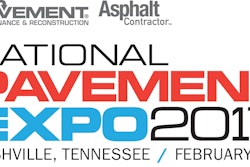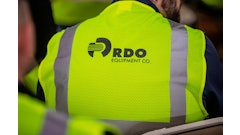
Parking lots and driveways don't have to be an afterthought to a new commercial or residential construction project.
But at times they are. To save money on new construction, an owner may insist on a 2-in. asphalt overlay over granular base, rationalizing that only passenger cars are going to be using the drives and parking areas.
This rationale is blown out of the water as refuse trucks right away begin to visit the concrete dumpster pad, and ruts promptly appear leading up to it. The ruts lead to cracking, which allows ingress of water into the base, leading to late winter potholes.
Regrettably, that's only the beginning of paved surface headaches for the owner.
An answer is thicker, stronger, multiple lifts of asphalt on granular base, or fresh asphalt overlays on existing pavements, both of which provide the aesthetic look that gives customers confidence in doing business with commercial or professional interests located in the facility.
"Pavements in parking areas that are initially under designed can experience excessive maintenance problems and a shortened service life," reports the Colorado Asphalt Pavement Association. "In addition, selecting the right materials for the asphalt pavement can assure a pleasing and attractive surface."
But long-term cost effectiveness can be an even more important driver than aesthetic pleasantness, CAPA says. "When properly designed and constructed, parking areas can be an attractive part of the facility that is also safe, and most important, usable to the maximum degree. Parking areas should be designed for low maintenance costs and easy modification for changes in use patterns."
Multiple Lifts Save Money
Ideally, asphalt pavements for commercial parking areas or drives typically are placed in "lifts," or layers, for a total compacted thickness of 3 or more in.
"For example, a total of 3 in. may be placed in two layers each 1.5 in. thick when compacted," explains the National Asphalt Pavement Association. "A good way to pave a 4-in. pavement is to first place about 3 to 4 in. of loose asphalt, and compact it to a thickness of 2.25 to 3 in., and then tack the surface and pave the remainder and compact again. In this case, different mixes could be used in each layer, such as a mix with larger stones (12.5 mm nominal maximum aggregate size, NMAS) for the lower layer and smaller stones (9.5 or 4.75 mm NMAS) for the surface layer. The finer surface mix provides a uniform, attractive, impermeable, and strong surface."
For typical residential driveways, an aggregate base layer of 6 to 8 in. of compacted crushed aggregate is recommended by the Asphalt Institute on top of a stable, prepared subgrade. This course is followed by approximately 2 in. compacted of dense-graded HMA base and 1.5 in. compacted HMA surface mixes.
While project owners may want to skimp on the depth of asphalt of their parking lot or drives, that extra inch or two of asphalt provides owner benefits way beyond the initial cost, says Jim Huddleston, executive director of the Asphalt Pavement Association of Oregon (OPAO).
Huddleston explains that adding one inch of asphalt to the pavement can double the fatigue life of the structure, whether a state highway, county road, municipal street, or commercial pavement or driveway.
"If a 3-in. pavement is expected to last 20 years, for example, adding one inch of asphalt will increase the fatigue life to 40 years," Huddleston says. "Adding another inch will double the fatigue life again (to 80 years). A road need only have an asphalt thickness of 5 to 6 in. in order to have perpetual properties (such as cracking and rutting developing at the surface rather than bottom-up)."
While 5 to 6 in. of asphalt may go beyond the needs of commercial facility owners, for a new construction project, adding one more inch of asphalt typically amounts to no more than the cost of the material itself and delivery to the site, Huddleston says.
"It's the cheapest inch of asphalt you’ll ever buy,” he said, as the life-doubling benefits of an extra inch of asphalt can be reaped for both new pavements under construction as well as existing pavements that have already held traffic.
Emulsions for Bond Coats
Whether you are placing two or more lifts of asphalt on a parking area, or overlaying an existing driveway or parking surface, the rule remains the same: for durable pavements, bond the layers of asphalt with a bond coat, also called a "tack" coat.
An asphalt emulsion is a homogeneous mixture of two insoluble substances, oil and water. In it particles of liquid asphalt (the dispersed phase) are surrounded by molecules of water (the continuous phase). Compared to hot liquid asphalt, asphalt emulsions have greatly reduced viscosity, are safe to use at lower temperatures, and allow liquid asphalt to be spread more evenly and thinly.
Emulsified asphalt is produced by dispersing tiny globules of asphalt cement into water treated with a small quantity of emulsifying agent. The dispersion takes place in a powerful blender, called a colloid mill, where spinning blades break or shear the liquid asphalt into suspended microscopic particles. The water, or soap solution, is immediately introduced to form the emulsion.
The emulsifier – an engineered surfactant (detergent) or surface-active agent – maintains the microscopic asphalt droplets in a stable suspension, keeping them from recombining. The amount and type of surfactant used, along with other variables, controls properties of the emulsion critical to performance in the field application.
For example, emulsifiers affect the “break” time following placement on a road, in which the water evaporates, leaving the residual asphalt behind. Asphalt emulsions partially are categorized as rapid setting (RS), medium setting (MS), slow setting (SS) and quick setting (QS) emulsions.
Today, the most common types of emulsions used for bond coats include slow-setting grades of emulsion such as SS-1, SS-1h, CSS-1, and CSS-1h and the rapid-setting grades of emulsion such as RS-1, RS-2 and CRS-1.
Bonding Asphalt Layers
Bond coats utilize either straight liquid asphalt, cutback asphalt, or asphalt emulsions, but for a number of reasons, asphalt emulsions constitute the lion’s share of bond coat applications by far, according to National Cooperative Highway Research Council (NCHRP) Report 712, Optimization of Tack Coat for HMA Placement (for your copy, search “NCHRP Report 712”).
“The most widely used tack coat material in the world is emulsified asphalt,” NCHRP reports, adding emulsified asphalt, or asphalt emulsion, is a nonflammable liquid substance that is produced by combining asphalt and water with an emulsifying agent. A survey in the report indicated that worldwide, approximately 92 percent of tack coat applications utilized asphalt emulsions.
It’s easy to see why asphalt emulsions are preferred for bond coats. Straight or “neat” liquid asphalt must be kept heated to stay liquefied, and that poses burn hazards and other safety problems as the distributor moves around on the site.
An asphalt emulsion bond coat, when sprayed onto pavement, functions as a glue to hold existing and new pavement layers together. It enhances the bonding of individual pavement layers so they function as a single, unified pavement for improved strength and durability. When properly bonded, the resulting pavement structure uniformly distributes traffic load stress. Without proper bonding, each pavement layer works independently, failing to distribute stress evenly, leading to cracking, rutting, slippage and other distresses that destroy road quality.
In the same way that fragile, thin veneers of wood are glued to each other to form a robust sheet of plywood, research shows layers of asphalt pavement perform better when bonded to each other.
“An emulsified asphalt tack coat produces a strong adhesive bond without slippage between an existing pavement and a new overlay,” reports the Colorado Asphalt Pavement Association in its 2013 report, Best Practices for Applying Undiluted Emulsified Asphalt Tack Coats. But the performance of this adhesive bond can be endangered by poor placements.
Yet best practices are well established. For example, for maximum service, bond coats should be evenly distributed across the full width of clean pavement, not just as the commonly seen narrow spritzes on the substrate. Spray bar nozzles must overlap, ideally in multiples of three; triple overlap is recommended for higher application rates such as chip seal, but may not be achievable for lower rates of bond coats.
The emulsion must be dispersed with the right spray pattern, at the right temperature and volume. Long after the paving is completed, inadequate adhesion between two layers of bituminous mix may cause problems in the mat above.
An asphalt overlay will make an older driveway or parking area look new, so long as the existing pavement is sound structurally. The contractor should repair any potholes, cracks, or areas which have been softened due to spills or drips of petroleum products. Alligatored areas, widened joints and cracks certainly will reflect through the new overlay, and must be repaired or mitigated prior to overlay.
A complete brooming — followed by a complete asphalt emulsion bond coat spray -- will adhere the new 1.5- to 2-in. overlay to the substrate.
“If [the overlay] can’t stick it’s not going to bond,” said consulting engineer Dale Decker, P.E., at a seminar on tack coats during World of Asphalt 2015 in Baltimore. “And if we don’t get the bond, we’re wasting our money.”
Moreover, from the owner and contractor point of view, this bonding of layers via asphalt emulsions comes at a relatively small price.
“An analysis of bid tabs using 2013 data shows that the cost of tack coat is relatively minor compared to other components of a typical paving project,” Decker said. “Therefore, the risk of a poor or a compromised bond from not applying tack should be deemed too great when one considers the ramifications of the loss of fatigue life from this condition. Tack is such a cheap component that it makes little sense to shortchange this critical step and introduce so much risk.”
For more articles on emulsions, visit ForConstructionPros.com/asphalt and Search 12208089 for "With Asphalt Emulsions, High Float = High Performer," or 11408541 for "How Tack Coat Improves Your Asphalt Paving."














![Lee Boy Facility 2025 17 Use[16]](https://img.forconstructionpros.com/mindful/acbm/workspaces/default/uploads/2025/09/leeboy-facility-2025-17-use16.AbONDzEzbV.jpg?ar=16%3A9&auto=format%2Ccompress&fit=crop&h=135&q=70&w=240)




